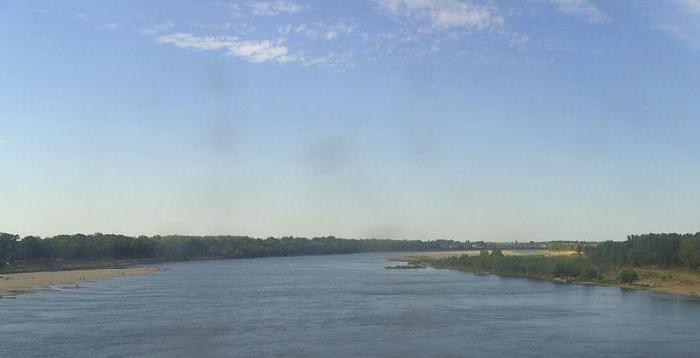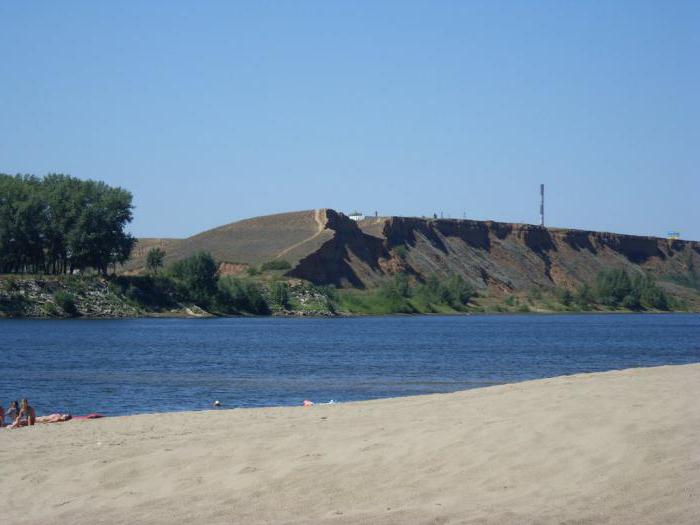Speaking strictly scientifically, Akhtuba is not a river, but one of the branches of the Volga. But its considerable length, the nature of the channel and the hydrological regime bring the stream to the rank of significant water arteries, which the country of Russia is rich in. Akhtuba River is a recreational area. Fishing enthusiasts also appreciate it. The waters of Akhtuba irrigate numerous melons and fields in the northern reaches of the river. Also on this stream the Volzhskaya hydroelectric station was built. In a word, Akhtuba deserves to be given more attention to her. In this article, we describe the water artery. In addition to geographical characteristics, we will talk about the features of rest on Akhtuba and its wildlife. It should be said that the modern length of the Volga arm is several kilometers shorter than the old one. The Volzhskaya hydroelectric station dam blocked the entrance to Akhtuba. To prevent the flow from disappearing, an artificial channel was dug to its channel six and a half kilometers long.

Mother and daughter
In its lower reaches, the great Russian river Volga, before pouring its waters into the Caspian Sea, is divided into several branches. Thus, Akhtuba is not a tributary, but one of the outflows. She can be called the daughter of the Volga. The river Akhtuba received its name from two Turkic words. “Ak” is “white.” As for the second syllable, scientists cannot come to a single conclusion. If you call the sleeve of the Volga "Ak-Tyube", then this translates as "White Hills". Those really exist, in some places the river forms steep, light shores. And if we assume that the name of the stream came from the Turkic "Ak-Tepe", then "White Whirlpool" comes out. And indeed, quite often a river, the depth of which usually reaches two meters, presents surprises - pits. They like to live in carp, zander and large catfish. The depth of such whirlpools can reach thirty meters.
Hydrographic parameters
The depth of the Akhtuba River has already been mentioned by us. What about other features? To begin with, as the left arm of the Volga, modern Akhtuba is born in the northern suburbs of Volgograd, a kilometer from the dam of a hydroelectric power station. But the river does not flow into the Caspian Sea, as one might assume. Not far from Krasniy Yar (a settlement twenty-five kilometers upstream from Astrakhan), Akhtuba merges with another stream from the Volga delta - the Buzan sleeve. It is considered the main one. Thus, south of the confluence point, the flow already flows under the name of Buzan, and then, branching into numerous shallow channels, flows into the Caspian Sea. But back to the water artery called Akhtuba. The length of this river is five hundred thirty-seven kilometers. The width of the Akhtuba channel reaches two hundred meters, and in the flood - even three hundred. But before the construction of the Volga hydroelectric station, the sleeve spilled over twenty or more kilometers. The water level in the Akhtuba River depends on the seasons. But now such a factor as the Volzhskaya Hydroelectric Power Station has appeared. The river level is regulated by the discharge of water from the dam. Akhtuba floods occur in April and May. Under the ice, the river is three winter months. The average annual water discharge in Akhtuba is 153 m³ / s.

Value in the household
The Akhtuba River flows through an area with a rather arid climate. And therefore, its waters are of great importance in irrigation of agricultural land. It is especially important in the Volga-Akhtuba floodplain, which is a supplier of fruits, vegetables and watermelons. On the banks of the river are such cities as Volzhsky (at the beginning of the outflow from the great Russian river), Znamensk, Leninsk, Akhtubinsk. Five kilometers from the sleeve is Kharabali. The Volga-Akhtuba floodplain is the largest on earth. It is not only a center for gardening and growing gourds, but also a cattle breeding center. In addition, she is very fond of fishermen. The floodplain invariably gives them a rich catch. The area of the Three Rivers is especially rich in fish. Sixty species of river inhabitants live there.
What is the Volga-Akhtuba floodplain
450 kilometers of the 537 sleeve flows very close to the main river. The distance between the water flows is variable, but the “daughter” always remains connected with the “mother-Volga” by countless channels called “eriks”. The width of the floodplain varies from ten to thirty kilometers. The Akhtuba River is very winding; it creates numerous rifts and meanders. Therefore, there are so many “ilmens” in the floodplain - small and shallow remnant lakes. In hot summers, these ponds dry up. But in April and May the entire floodplain territory is flooded. The depth of water at this time reaches two, and in some places - eight meters. Low water is observed in July and August. In autumn, especially in November, the river is fed by heavy rains, but its level is still not as high as in the spring flood. Ninety percent of the floodplain territory belongs to the Astrakhan region, and only its extreme north is Volgograd.
Relief
The Akhtuba River, flowing along soft soils, creates low banks. They are rugged by eric and ducts. But sometimes there are quite high, steep banks. These bright hills, due to which Akhtuba may have got her name, are called here “cool people”. Their height reaches eight meters. The bottom of Akhtuba is sandy, sometimes clay and silty. The river often changes its course. These abandoned ducts or eriks are called Old Akhtuba, or Dry. The flow velocity of the left arm of the Volga ranges from ten to forty centimeters per second. But in May, during high water, this parameter can increase to 0.9 m / s.
Climate and nature
Akhtuba flows through the forest-steppe zone. In summer, quite hot and sunny weather is set here. The air warms up to thirty-five degrees in the afternoon. And the nights here are by no means cold: + 20-25 0 . The water temperature in the Akhtuba River reaches its peak in August. Usually this figure is 24-25 degrees, but sometimes the flow warms up to plus twenty eight. Even smaller shallows and old lake are warmer. September is very comfortable in the lower reaches of Akhtuba. In deciduous forests and oak forests on the banks of the river there is a lot of game. Herons, snakes, and even turtles are found in reeds and willow. But poisonous snakes on the shores of Akhtuba, except for the steppe vipers and muzzle insects, were not noticed. Mosquitoes, by the way, get their buzzing only two hours a day - after sunset. The natural landscapes of Akhtuba are very diverse. Anyone can choose a landscape for themselves, whether it’s an old pond hidden from prying eyes by a reed wall, a wide river expanse or a narrow erik channel.

Rest on the river Akhtuba
First of all, this sleeve of the Volga is known among fishermen. And not so much the whole of Akhtuba, but the area near the Three Rivers. Under the cool-boiled carp is kept. And deep bottom holes serve as a haven for flock zander and huge catfish. Fishing on Akhtuba is possible at any time of the year. In recent years, due to global warming, prolonged thaws are possible when the river and river rapids are freed from ice. Then fishing becomes a dangerous activity. Locals have long noticed: a good bite occurs when the “seaman” blows - the wind from the Caspian. But even at another time, from a beginner to an ace, trophy fishing awaits on Akhtuba. Crayfish abound in the river. The only minus of fishing in May-June is a surge in activity of the Astrakhan midge. But during this period the best nibble is observed.
When to relax on Akhtuba
Sandy beaches on the Akhtuba River seem attractive throughout the summer months, and even in September. But if you want to get the most comfortable stay, then you should delve into some of the nuances. June weather is very good. And the Astrakhan midge appreciates this. It is in the first month of summer that the peak of the flight of this gnat is observed. There is an incentive for fishermen to sit in mosquito equipment - a rich catch. But those who decide to undress before swimming trunks in June on the Akhtuba River, are not waiting for a very pleasant surprise. Then maybe July? A beach vacation in mid-summer on Akhtuba can only withstand a native of the Sahara. The temperature in the shade can reach forty degrees, and the sand is heated so that it is not possible to step on it. No breeze, no rain. Weather in August favors holidaymakers. Water in Akhtuba warms up to + 24-28 0 , in the afternoon the fresh breeze softens the heat. But sometimes there are so many holidaymakers that the most important thing in outdoor recreation is lost - privacy. But September is the best time to come to the shore of Akhtuba. Mosquitoes and other blood-sucking insects already cease to pester. The ranks of vacationers are also thinning. But the watermelons, berries and fruits ripen. What about the weather? September in Akhtuba in terms of temperature can be compared with June in the suburbs. So it’s quite possible to skimp and sunbathe.
Recreation facilities on the river Akhtuba
When it is best to go to the left sleeve of the Volga, we have already found out. Now it remains to decide where to stay. The recreation centers located in the Volga-Akhtuba floodplain are especially appreciated. Lapis lazuli is one of them. Guests are accommodated in the rooms of the building or in the cottages. On the territory of the recreation center there are saunas, pools, children's and sports grounds. A real VIP-rest is provided to the guests of Athens, which is located near the Sredne-Akhtubinsky bridge. On the recreation center "Veterok" there are both the hotel "Fisherman's House" and small houses, designed to accommodate from three to ten people. This complex has its own sandy beach. From inexpensive bases of the Volgograd region, you can recommend "Relight". It is located ten kilometers from the city of Volzhsky, in a picturesque place in the middle of a forest park.